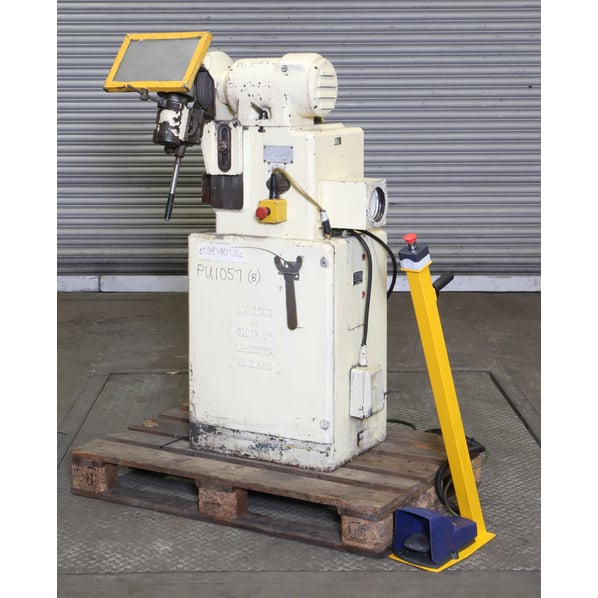Burrows & Smith D-Burr Gear Deburring Machine


Auction
- Our partner auctioneer is
- Peaker Pattinson
- Part of an Auction
- Clearance Auction
- Lot ID
- PU1057B
- Model
- D-Burr
- Other Info
- Gear De-burring system
- Location
- Clearance Auction
- Weight (kgs)
- 364
- External Dimensions (WxDxH mm) [?]
- 550 x 675 x 1375
- Delivery Your delivery options
Description
Burrows & Smith D-Burr Gear Be-burring Machine
D-Burr Design and Capacity
In the production of gears, by either hobbing or shaping, the formation of burrs are inevitable. The D-Burr is an efficient machine designed to remove these burrs from spur, bevel and helical gear teeth up to a 25° helix angle. Sprockets and other components which have equi-spaced teeth around the periphery of a machined blank (maximum diameter 300 mm) can also be accommodated irrespective of tooth form.
Operation
The workpiece, mounted on the freely - rotatable spindle of the workhead, is brought into mesh with the special pre-formed grinding wheel. The grinding action causes rotation of the workpiece, removal of the burr and chamfering of the edges of the full tooth profile in a continuous process to a predetermined depth set through a graduated scale and controlled by a dead stop.
The Workhead
The workhead can be adjusted through 30° either side of the grinding wheel to allow for the deburring of helical gears. The complete workhead can be adjusted longitudinally, for the utilisation of the full width of the grinding wheel, or vertically to influence the angle and size of chamfer ground. The patented hinge action of the assembly allows the introduction of the work to the wheel, up to a spring loaded stop, in one simple movement.
The Grinding Unit
The grinding wheel head is a self-contained unit incorporating a 350W stator and motor unit capable of 12 starts per minute. The wheel head can be adjusted transversely.
A magnetic brake, housed in the motor casing, also acts as a safeguard by stopping the grinding wheel spindle immediately when switched off.
The built in dust extraction unit is driven by a separate 1/3 h.p. motor and dust collection bags are housed in the rear of the machine .
Production
To quote a typical example of production on this machine - both sides of a 43-tooth, 8 DP, EN. 2.4 steel gear (Fig. 3) are de- burred in a total time of 16 seconds. Using the standard wheel supplied with the machine, 2000 gears are de-burred before the wheel requires re-forming. The work had previously been performed by hand in a minimum time of 2 minutes per component.
Specification
Diameter of grinding spindle - 0.9847” diameter
Taper - 1-5
Workhead swivels to left and right - 30degrees
Max/Min diameter of spur gear - 12”/1”
Max/Min diameter of bevel gear - 10”/2”
Maximum diametrical pitch - 5
Maximum helix angle - 25degrees
Maximum pitch - 0.628”
Maximum weight of gear - 14lb
Maximum thickness of gear - 4”
Grinding wheel (marked Burrows & Smith D-Burr Machine) - 8” diameter x 1 ¼ “ wide x 2 3/8 diameter bore
Maximum diameter of wheel - 5 ½ “
Main motor - ½ h.p. C.R. 400/440v, 3 phase, 50 cycles
Speed - 2720 r.p.m. 12 starts/min
Braking power provided - 4” magnetic brake 61 lbs/ft. retarding torque
Dust extractor motor (airstream) - 1/3 h. p. C.R. 400/440v, 50 cycles
Speed - 2850 r.p.m
Floor space required - 22” x 16”
Approx. net weight of machine - 720 lbs
Approx. gross weight of machine - 870lbs
Approx. dimensions of machine boxed for export - 2’3” x 1’11” x 4’10”
![]() Print / Download Burrows & Smith D-Burr Gear Deburring Machine Datasheet
Print / Download Burrows & Smith D-Burr Gear Deburring Machine Datasheet
Auction Lots Descriptions and photographs are provided in good faith but may not be correct. It is the Customer's responsibility to ensure that the machinery is fit for the purpose for which it is purchased and safe for the purpose of use at work via physical inspection. All sales are deemed to be 'as inspected' and 'as is, in situ' even if the customer has waived the right to inspect.
Machines & equipment for sale
- Surface Treatment
- Cleaning & Degreasing
- Polishing & Belt Linishing
- Mass Finishing
- Ovens & Furnaces
- Process Cooling
- Shot Blasting
- Dust & Fume Extraction
- Air Compressors
- Rectifiers & Transformers
- Miscellaneous
- Latest Stock
- Special Offers
- Direct From Site Clearances
- Auctions
- Brand New Machines
- Available Immediately
- Sell Your Machine
Machine Alert
Get the latest machines emailed directly to you as they become available to buy online. Sign Up Now






